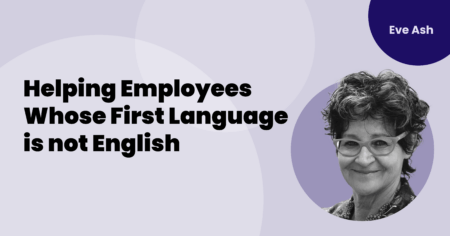Communicating with employees who do not have English as their first language presents unique communication challenges for co-workers and for customers. There can be problems with grammar, tone, intent or body language.
Common communication errors – how important are they?
Grammar
Mistakes in grammar can be annoying but usually they can be understood – so should they be corrected or not? The answer lies in how much it impacts customers or reflects poorly on the business. A good strategy is to identify and address the most common grammatical errors. These include:
- Using definite and indefinite articles incorrectly:
- Meeting is tomorrow. We should not make the noise.
- Not putting the “s” on plural count nouns:
- Give us five minute.
- Using plural ‘s’ for nouns that do not have a plural form (i.e. they do not add ‘s’):
- We need more informations about the product?
- Could you give us some advices?
- Using the wrong preposition:
- It depends of the situation.
Rhythm and Intonation
Usually people from a non-English speaking background (NESB) use the rhythm and intonation patterns of their first language when they speak English. This can make their pronunciation difficult to understand, or it may sound too direct, rude or even aggressive to English speakers. Even advanced speakers of English may continue to make these mistakes and be misunderstood.
Cultural differences
What is considered polite and respectful language in one culture may not be seen the same way in another. Greetings are a good example. Who we greet, when we greet them, and the language we use is not standard across cultures. NESB employees can sound rude even when they believe they are showing respect. Linguistic mistakes are often cultural and they are not a reflection of intelligence!
Gestures, body language and silence are also very important in communication and these too are different in different cultures.
How can managers and team leaders help with communication problems or breakdowns?
- If communication errors are a serious issue in an organization, employers can provide help for NESB employees with coaching or online learning.
- Managers and team leaders can build communication bridges with NESB team members and create a workplace where employees communicate successfully, and misunderstandings are quickly identified and ‘repaired’.
- Let NESB employees know if their language or cultural issues are causing problems with colleagues or customers, and talk about solutions. Make yourself available to discuss any problems they are having.
- Discuss cultural differences – what individuals think is respectful language, and how to ‘read’ gestures and body language. Compare what is common in your country with others, e.g. eye contact, hand gestures, head movements, facial expressions, sitting postures, physical contact and the distance we stand from someone we are talking to. These can have very different meanings in different cultures, and these differences are not always obvious or understood.
- Give feedback that identifies specific problems or situations rather than generalizations such as ‘You make mistakes in English.’ ‘People can’t understand you.’ ‘People think you’re rude.’
- NESB team members or even customers may ask very direct questions such as “Why did you…?”, “Why don’t you..?” or “Why aren’t you…?” English speakers are more likely to soften these questions with “I was wondering …?”, “Is there any reason …?”, or “Could you explain …?” Help NESB employees become aware of these nuances and, before you respond to the tone of a question or the exact words, clarify what the person intends.
- In your team, discuss silence. English speakers generally link silence with unwillingness to participate and/or lack of interest. In other cultures silence can have a different purpose. It may be a way of taking time to think and give a considered or a correct answer. It can be participating with respect by letting others speak first, e.g. those who are older or more experienced.
- Be aware of and discuss linguistic politeness, i.e. saying you understand when you don’t. Under confident English speakers may do this as well as NESB team members. It is a form of politeness, to meet expectations, to avoid conflict or confrontation, to save face and avoid feeling stupid or embarrassed. It’s wanting not to let people down, trying to please the other person.
- Recognize and acknowledge improvements: “I thought the email you sent was really well-written. It’s very clear – you are improving.” Often people don’t recognize their own communication improvements but they will be motivated if they receive praise from managers, team leaders and co-workers.
Eve Ash is a psychologist and CEO of 7 Dimensions. She is the producer of hundreds of videos and online courses, available through OpenSesame. In recent years she has teamed up with linguistics specialist Dr Fran Byrnes to create 60 courses for workplaces with non-English native speakers – to help them and their supervisors develop skills to improve language and coaching.






